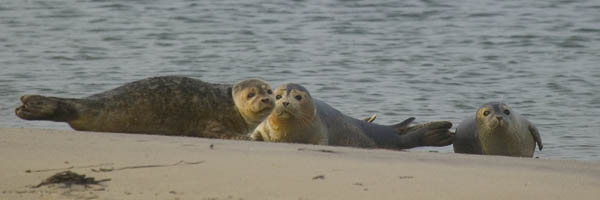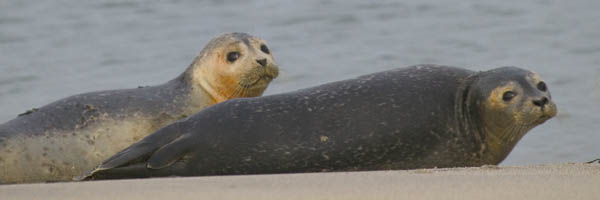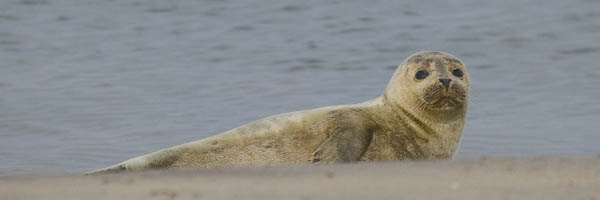
Gallery Photographers
Partner
Artist-in-Residence
Guest Online
Links
Read other articles of
Bill's Walkabout Journal
Send an email to Bill
Bill Bernbeck
Bio
Artist Statement Journal
Gallery
Walkabout Journal
Dancing with Seals
The far southwest tip of
My journey there would be on foot. It’s early January, and
a late afternoon start would give me about two hours of daylight for the
walk. Packing my usual inventory of camera gear and tripod, I hoped to find
a photogenic sunset gracing some feature of that sandy peninsula.
From an earlier reconnoiter I found a trail along the
harbor side of the point. The path was at the high tide line. To my left,
the sand dunes provided a welcome shelter from the cold wind blowing off the
ocean. The sand underfoot was sometimes firm, sometimes mushy. Progress was
intermittent as I found my way through the uncertain footing. The day was
cold and damp. The chill found its way through the folds of my parka and
sweater. Movement was the only way to keep warm.
A yard to my right, the waters of
It was a seal. I had been fairly close to it and did
not realize it was there. My approach must have startled it, and it scurried
to reach the water. It was visible for only a few seconds and then gone. It
would undulate its body clumsily as it flopped along.
Well – Darn! I probably missed my only
opportunity to capture a picture of a seal in its habitat. I promised myself
to be more vigilant now that I knew these animals might be in the area. I
stopped walking and studied the beach ahead. It might prove beneficial to
identify some of that upcoming “flotsam”.
I had my answer in a few minutes. A slight movement in a
pile of driftwood farther ahead caught my attention. I set up my tripod and
put the long lens on the camera, aimed it at the driftwood pile, focused,
and – oh yes!

The driftwood pile turned out to be a group of seals lying
out on the beach. Their bodies looked more like logs from this distance.
They were laying about in a casual arrangement. There was one smaller seal
lying fairly close to the water’s edge, another larger one was almost into
the dunes. The main group made up a mass of bodies that had no real
definition yet. An occasional roll or shuffle was all that gave their
presence away.
My guess is that they are gray seals. An article in the
local paper told how gray seals come to
The
gray seal
(Halichoerus
grypus, an inglorious name that translates as ‘hooked-nosed sea pig’)
is found on both shores of the
Now what do I do? They were directly ahead, somewhat
close to the pathway.
My best (and only) course would be to continue
to walk slowly along the beach path. There was a clearing ahead where the
dunes tapered away into a wide area of level beach out to the point. I might
be able to reach that clearing, veer off away from the seals, and not
disturb them. They were bound to see me coming. They probably detected me
long before this. Since they had not already bolted, they must have some
tolerance of human presence. Along the way, I would pause and maybe get a
camera shot somewhat closer in.
I proceeded ahead. About every fifty yards, I would
stop and look at them through the camera lens. They stayed in place, and I
would proceed ahead another few yards.
I eventually got close enough to where their
features became more apparent, and I started to take a picture with each
stop. They remained in place as I reached the clearing, glancing at me now
and then. I again stopped and made a few more exposures, and decided to
remain there and just observe.

Two features on these seals impressed me.
First, their bodies are so neatly streamlined. I
know they have flippers, but they are tucked very close into the body mass.
They looked like smooth, limbless torsos that end in a head with small
whiskers. No wonder their movement on shore was ungainly.
Then there are the eyes. They are big, black, puppy dog
eyes. Their eyes stand out clearly on that otherwise featureless head and
body. They are so prominent that you can tell when they are looking at you
from far off. They give a look that seems to plead for your attention and
friendship.
After about twenty very cold minutes of standing and watching, one of the seals made its way into the water, followed by the smaller seal already at the water’s edge. Over the next five minutes, the remaining seals did the same. Once in the water they were in their element. They swam a little offshore and bobbed with their heads above the surface, maintaining their position in the swift tidal flow with minimal effort. They eventually disappeared under water, and made their way somewhere farther offshore.

The encounter was all too brief. It was not an extraordinary experience. Certainly, the seals made no big deal of it. The opportunity to photograph them was engaging and stimulating. It added an element of adventure to the walk.
I enjoyed that happenstance encounter. In time to come, I
won’t remember the damp cold and wind. I won’t remember the temperamental
footing of the sand path. I will remember those big engaging eyes. I will
remember sharing a time and place with them in their own world.
Bill Bernbeck
March 2008
Read other articles of
Bill's Walkabout Journal
All images and writings Copyright Bill Bernbeck
585.271.2540
In the heart of ARTWalk in the Neighborhood of the Arts